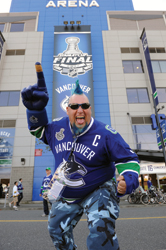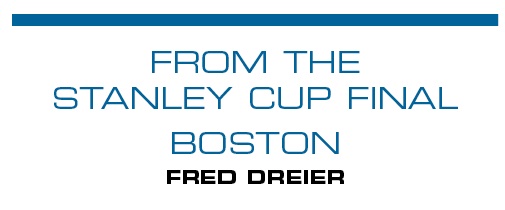The Vancouver Canucks’ success during the Stanley Cup playoffs has helped lift the NHL’s total North American television audience to new heights, as NBC and Versus have seen slight losses in American viewership but the CBC has enjoyed its biggest audience in years.
Viewership numbers from the Stanley Cup Final between the Canucks and Boston Bruins — who had not made the Finals since 1990 — defied the conventional belief that a medium-sized Canadian city cannot compete with major American markets. The Final has produced more total viewers than 2010, which featured two of the NHL’s largest markets, Chicago and Philadelphia.
Game 1 earned a 3.2 overnight rating on NBC with 4.56 million average viewers, the best U.S. rating for a Final opener since 1999 and a 14 percent increase over last year. Factoring in the Canadian broadcast on CBC, the game drew 10.16 million North American viewers, as CBC’s “Hockey Night in Canada” averaged 5.6 million viewers and peaked at 7.8 million. Games 2 and 3 on NBC and Versus both slipped significantly in U.S. ratings — Game 2 tumbled 39 percent to a 2.2 rating and Game 3 slipped 23 percent to a 1.6. But robust Canadian viewership helped the games boast total viewership of 9.17 million and 8.16 million, respectively, which make each the most-watched comparable Final games since 1994.
“We definitely sent out more of a North American view of our business this year,” NHL COO John Collins said from Game 4 in Boston. “It’s more satisfying than surprising because every league tries to be less dependent on the big markets.”
The Final numbers reflected those from the earlier rounds, which saw relatively flat numbers by NBC and Versus but sizable gains by the CBC. Through its first nine playoff games, NBC’s average of 1.93 million viewers was up by just 40,000, and its 1.2 rating was even with 2010 ratings. Versus’ average viewership of 854,000 through the first three rounds was up 79,000 over the average for the first two rounds of 2010. The CBC, however, averaged 2.38 million viewers for the first three rounds, a 22 percent increase from 2010. The third round’s average of 3.0 million viewers marked the network’s best performance ever for that round.
“There is pent-up interest in Canada for a Canadian team to do well,” said David Masse, senior director of CBC Sports. “Vancouver is doing particularly well because they have a large fan base and people are expecting them to do well.”
 |
GETTY IMAGES
The Canucks led the league in merchandise sales during the playoffs, averaging 500
jersey sales a game. |
■ RING THE REGISTER: Collins said the jump in Canadian viewership will allow the league to sign more corporate partnerships that package the U.S. and Canada. Currently, the league has nine North American partners: Cisco, Bridgestone, Enterprise, PepsiCo, BlackBerry, Compuware, Ticketmaster, Reebok and Sirius/XM. Keith Wachtel, NHL senior vice president of integrated sales, said the league is in final negotiations to extend its U.S. deal with Honda to include Canada.
“I think [the 2011 playoffs] proves that we are the only true North American sport,” Wachtel said.
Wachtel said the league also will look to open North American deals in the spirits, men’s personal care and consumer electronics categories for 2012. In the latter category, the league hopes to bring on a partner whose assets can aid the league’s international broadcast and broadband expansion, as well as its requirements for the planned broadcast center in Toronto. At the national level, the league is in renewal discussions with Canadian partners Bell and Visa, as well as American partners Verizon, Geico, McDonald’s and Discover.
■ SELLING THE SHIRTS: Vancouver led the league in merchandise sales during the playoffs. According to Jim Haskins, NHL vice president of consumer products, the Canucks have averaged selling approximately 500 jerseys a game during the postseason, 300 more than the league average. The team also saw its sale of gifts and novelty items such as pucks and car flags increase 200 percent at Canadian retailers Canadian Tire and London Drug. The boost helped the league increase its total online merchandise sales during the postseason by 8 percent over 2010 after only three playoff rounds.
“That is a tremendous number when you consider the size of Chicago and Philly in [the 2010 Finals],” Haskins said. “Both the Canucks and Bruins jerseys are sold out from a wholesale perspective.”
Keith Leach, director of merchandising for Reebok, said Boston represents a bigger market for championship merchandise sales. Leach predicted Boston’s market demand to be similar to that of Chicago, which produced healthy seven-figure sales in championship T-shirts and headwear. “On paper, Vancouver is 50 percent of Chicago,” Leach said. “But they have not experienced the hot-market phenomenon in a while, which could bring them up to that level.”
■ OTHER METRICS: The Canucks led the league in online metrics for the playoffs. According to team COO Victor de Bonis, the team’s website attracted 2 million unique visitors during the month of April, which is traditionally the busiest month on NHL.com. That number indexed 58 percent above the league average for unique visitors during April and represented a 300 percent increase in unique visitors from Vancouver’s 2010 numbers. “Vancouver, Montreal, Chicago and Boston were our four top teams for the month of April,” said Perry Cooper, senior vice president of the NHL’s digital and direct marketing. “Vancouver is doing fabulously well, and they are really owning the marketplace.” The playoffs also generated impressive online metrics for the league. A source familiar with the league said that just under 10 million unique visitors went on NHL.com during the first three games of the Stanley Cup Final, which represented an 18 percent year-over-year increase. The league attracted 31 million unique visitors for April, which represented a 20 percent year-over-year increase. … Through 84 games the NHL had sold out 100 percent of its playoff ticket inventory for the second consecutive season. The league averaged 101.3 percent capacity, and the average attendance of 18,776 was slightly down from the 2010 average of 19,128.





